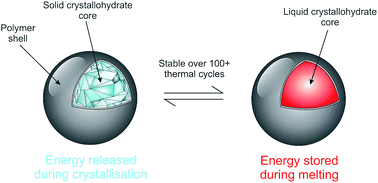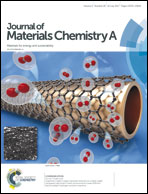Nanoencapsulated crystallohydrate mixtures for advanced thermal energy storage†
Abstract
Controlled storage of thermal energy, especially in the ‘low temperature’ region <230 °C, is very important for domestic applications, where effective heating and cooling of buildings is required in off-peak and seasonal periods. Additionally, domestic thermal energy storage systems have to provide energy mobility to expand their prospective application from buildings into other areas. The use of phase change materials (PCMs) can provide necessary storage and mobility levels. Inorganic crystallohydrate PCMs are non-flammable, have much higher latent heat capacity than organic PCMs and flexible transition temperatures, which depend on crystallohydrate composition. In this study, we demonstrated a universal method for encapsulation of crystallohydrate PCMs (Mg(NO3)2·6H2O and Na2SO4·10H2O) and their mixtures into 100–300 nm capsules with a poly(ethyl-2-cyanoacrylate) shell, employing in situ inverse miniemulsion polymerisation combined with ultrasonic treatment. Encapsulated crystallohydrates and their mixtures demonstrate high stability during energy uptake/release (>100 cycles as monitored by differential scanning calorimetry), due to the functional properties of the capsule shell and spatial confinement preventing water loss and incongruent melting during phase transitions. Mixtures of encapsulated crystallohydrates have differing energy uptake/release depending on their inherent design. Additive mixtures (mixtures of energy capsules containing single crystallohydrates) possess separate heat uptake/release transitions at temperatures corresponding to each crystallohydrate type. Latent heat of each transition is proportional to the content of the corresponding energy capsules in the mixture. Nanocapsules containing mixed crystallohydrate core have synergetic effects from Mg(NO3)2·6H2O and Na2SO4·10H2O components at their eutectic point: low-temperature phase transition and high latent heat capacity. Chemical composition, integrity and morphology of the capsules were analysed by scanning electron microscopy, Fourier transform infrared spectroscopy and thermogravimetric analysis.



 Please wait while we load your content...
Please wait while we load your content...